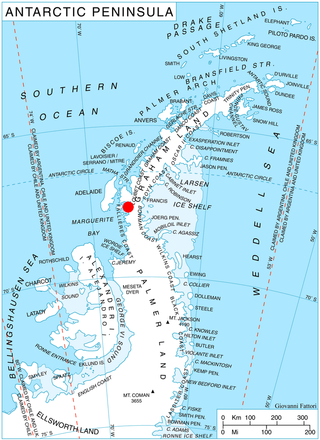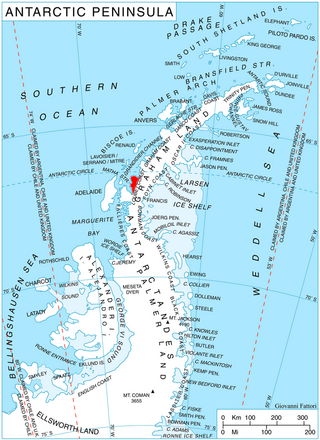The Neptune Range is a mountain range, 70 nautical miles long, lying west-southwest of Forrestal Range in the central part of the Pensacola Mountains, Antarctica. The range comprises Washington Escarpment with its associated ridges, valleys and peaks, the Iroquois Plateau, the Schmidt and the Williams Hills.

Mount Murphy is a snow-covered mountain with steep, rocky slopes rising to 2,634 metres (8,642 ft) in Marie Byrd Land, Antarctica. It is directly south of Bear Peninsula and is bounded by Smith Glacier, Pope Glacier, and Haynes Glacier. Volcanic activity began in the Miocene with the eruption of basaltic and trachytic lava. Volcanism on the slopes of the volcano resumed much later during the Pleistocene, with a parasitic cone having been K–Ar dated to 0.9 million years old.

Young Island is the northernmost and westernmost of the three main islands in the uninhabited Balleny Islands group located in the Southern Ocean. It lies 8 kilometres (5.0 mi) northwest of Buckle Island, some 115 kilometres (71 mi) north-northeast of Belousov Point on the Antarctic mainland.
Northeast Glacier is a steep, heavily crevassed glacier, 13 nautical miles long and 5 nautical miles wide at its mouth, which flows from McLeod Hill westward and then south-westwards into Marguerite Bay between the Debenham Islands and Roman Four Promontory, on the west coast of Graham Land, Antarctica.

The Prince Charles Mountains are a major group of mountains in Mac. Robertson Land in Antarctica, including the Athos Range, the Porthos Range, and the Aramis Range. The highest peak is Mount Menzies, with a height of 3,228 m (10,591 ft). Other prominent peaks are Mount Izabelle and Mount Stinear. These mountains, together with other scattered peaks, form an arc about 420 km (260 mi) long, extending from the vicinity of Mount Starlight in the north to Goodspeed Nunataks in the south.
The Mountaineer Range is the range of mountains lying between the Mariner Glacier and Aviator Glacier in Victoria Land, Antarctica. It lies to the south of the Victory Mountains and northeast of the Southern Cross Mountains.
Hadley Upland is a triangular shaped remnant plateau with an undulating surface, 1,500 to 1,900 metres, in southern Graham Land, Antarctica. It is bounded by Windy Valley and Martin Glacier, Gibbs Glacier and Lammers Glacier.
On the continent of Antarctica, the Aramis Range is the third range south in the Prince Charles Mountains, situated 11 miles southeast of the Porthos Range and extending for about 30 miles in a southwest–northeast direction. It was first visited in January 1957 by Australian National Antarctic Research Expeditions (ANARE) southern party led by W.G. Bewsher, who named it for a character in Alexandre Dumas' novel The Three Musketeers, the most popular book read on the southern journey.
Bentley Crag is a rock crag rising to about 1,000 metres (3,300 ft) north of Seue Peaks on Arrowsmith Peninsula in Graham Land. It was mapped by the Falkland Islands Dependencies Survey from surveys and from air photos, 1956–59, and named by the UK Antarctic Place-Names Committee after Wilson A. Bentley, American meteorologist and specialist in microphotography of snow and ice crystals; joint author with W.J. Humphreys of Snow Crystals.
Mount Bouvier is a massive, mainly ice-covered mountain, 2,250 metres (7,380 ft) high, immediately north of the head of Stonehouse Bay in the east part of Adelaide Island. It was discovered and roughly positioned by the French Antarctic Expedition, 1903–05, and named by Jean-Baptiste Charcot for Louis Bouvier, a prominent French naturalist. It was re-surveyed by the French Antarctic Expedition, 1908–10, and by the Falkland Islands Dependencies Survey in 1948–50.
The Boyle Mountains are a wall of mountains standing between the heads of Lallemand Fjord and Bourgeois Fjord, in Graham Land. They were mapped by the Falkland Islands Dependencies Survey from surveys and from air photos, 1946–59, and named by the UK Antarctic Place-Names Committee for Robert Boyle, the English natural philosopher whose book New Experiments and Observations Touching Cold provided the first major scientific and practical approach to a philosophy of cold in all its aspects.
Mount Bridgman is a prominent mountain which surmounts the central part of Liard Island in Hanusse Bay, which is a broad V-Shaped bay off the west coast of Graham Land, Antarctica. It was mapped from photos obtained by the Ronne Antarctic Research Expedition (1947–48) and the Falkland Islands and Dependencies Aerial Survey Expedition (1956–57). It was named by the UK Antarctic Place-Names Committee for Percy W. Bridgman, an American physicist who discovered the high-pressure forms of ice.
The Dorsey Mountains are a mountain range just east of Somigliana Glacier in the northern part of the Arrowsmith Peninsula in Graham Land. They were mapped by the Falkland Islands Dependencies Survey (FIDS) from surveys and air photos in 1956 to 1959 and named by the UK Antarctic Place-Names Committee (UK-APC) for Noah Ernest Dorsey, an American physicist.
Mount Moffat is a mountain, 1,250 metres (4,100 ft) high, standing 4 nautical miles northeast of Mount Ege in the Neptune Range, Pensacola Mountains, Antarctica.
The Gravier Peaks are prominent, ice-covered peaks, up to 2,120 metres (6,960 ft) high, situated 2 nautical miles (4 km) northeast of the Lewis Peaks on Arrowsmith Peninsula and extending in a northeast–southwest direction, on the west coast of Graham Land, Antarctica. They were first sighted and roughly positioned in 1903 by the French Antarctic Expedition under Jean-Baptiste Charcot, who named the feature for Charles Gravier, a French zoologist. They were surveyed in 1909 by the next French Antarctic Expedition under Charcot, at which time the individual peaks making up this group were first identified. The data for the present description is largely based upon a resurvey of the peaks in 1948 by the Falkland Islands Dependencies Survey.
Hansen Island is an island 6 nautical miles (11 km) long and 3 nautical miles (6 km) wide, lying immediately north of The Gullet at the head of Hanusse Bay, off the west coast of Graham Land, Antarctica. It was first surveyed in 1936 by the British Graham Land Expedition (BGLE) under John Rymill, who used the provisional name "North Island" for this feature. The island was resurveyed in 1948 by the Falkland Islands Dependencies Survey, and was renamed in 1954 by the UK Antarctic Place-Names Committee for Leganger H. Hansen, manager at Messrs. Christian Salvesen's whaling station at Leith Harbor, South Georgia, 1916–37, who gave great assistance to the BGLE, 1934–37.

Glavinitsa Peak is the peak rising to 1585 m in the central part of Rudozem Heights on German Peninsula, Fallières Coast in Graham Land, Antarctica. It has precipitous and partly ice-free northwest and south slopes, and is surmounting Bader Glacier to the north and Bucher Glacier to the southwest.

Zhelev Peak is the rocky peak rising to 1759 m on the west coast of Pernik Peninsula, Loubet Coast in Graham Land, Antarctica. The feature has steep and partly ice-free west slopes, and surmounts Lallemand Fjord to the west, Field Glacier to the north and its tributary Narezne Glacier to the northeast, and Haefeli Glacier to the south-southeast.

Erovete Peak is the rocky peak rising to 1824 m on the west coast of Pernik Peninsula, Loubet Coast in Graham Land, Antarctica. The feature has steep and partly ice-free west and southeast slopes, and surmounts Lallemand Fjord to the west, Haefeli Glacier to the southeast, and the lower courses of Finsterwalder Glacier and Sharp Glacier to the south.





